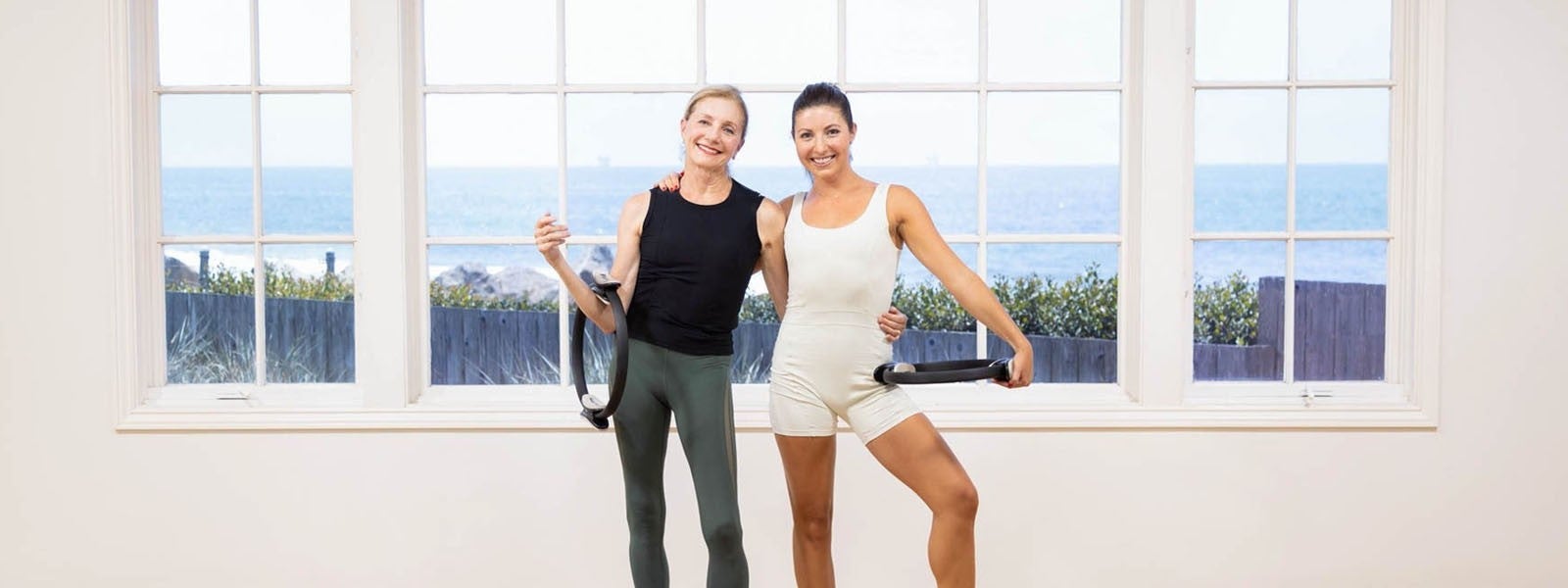
Magic Circle for Every Mood
Joseph Pilates was onto something when, as the possibly apocryphal story goes, he discovered that the metal hoops around wooden beer barrels (Germans love their beer!) served as an excellent prop for the series of exercises he called "Contrology."
These days, Magic Circles are often made of steel encased in soft rubber with two padded handles or grips on opposite sides. They’re available in different sizes and levels of resistance, depending upon the materials, and are easy to find online and in specialty stores.
Many Pilates exercises performed on the Mat as well as on the apparatuses can incorporate the Magic Circle, says Gia Calhoun, vice president at Pilates Anytime. "Magic Circle variations are a way for instructors to keep the work fresh and interesting, and for their students to find new connections in the body," she adds.
While instructors love to get creative and outdo each other with innovative uses of the Magic Circle, there’s lots about the Magic Circle for Pilates enthusiasts to love, too. That’s because no matter your mood, there’s a Magic Circle exercise for you.
The Pilates apparatuses such as the Reformer or Cadillac utilize coiled springs to create resistance. In some exercises, the springs provide an assist, making an exercise more accessible. In others, the springs add challenge. The flexible spine of the Magic Circle works the same way.
Looking for that old-school, feel-the-burn style workout? The Magic Circle can provide it. Having a harder time rolling out your Mat? Again, the Magic Circle’s got your back. Just want to get back under the covers? We hear you. But first, why not stretch with the help of the Magic Circle. It’s cheaper than a massage and you don’t even have to leave the house.
Pick your mood, grab your Magic Circle, and get moving.
Adding Challenge
This is where the Magic Circle really punches above its weight, says Calhoun. "Imagine you could break the Circle," is a common cue in these exercises.
To Try: Place the Circle between the inner thighs or ankles, or between the outstretched fingers of each hand to create more muscle engagement. Hugging the Circle reinforces the feeling of drawing both sides of the body into the midline, also known as "Centering," one of the six principles of Pilates. Try adding an inner thigh squeeze to your Bridging, or an inner leg/ankle squeeze in the Hundred. After all, isn’t Pilates known as a full-body exercise system?
Using the Circle this way also helps teach Pilates breathing, as the Circle widening and flattening is a visual reminder of the inflating and contracting of the abdominal region with each breath.
Placing the Circle’s pads on the outside of the ankles or thighs facilitates abduction, or the action of pulling away from the midline. Think of side-lying leg work in which the bottom ankle rests on the inside of circle and the ankle of the working leg presses upwards into the circle.
Adding an Assist
The Circle has a softer side, too. If you are new to Pilates, or just need some help with certain exercises, the Circle’s got your back.
To Try: The movement known as a “chest lift,” in which the head and tips of the shoulders lift off the floor, can be challenging for beginners. One of the Circle’s foam grip pads makes a great cradle for the back of the head. Press both hands into the top grip pad, and you’ve got both an assist for the head and neck and some bonus arm work, too. This hack is useful in the Hundred and the Series of Five, among other exercises that involve a chest lift.
Push-Ups are one of the most effective full-body exercises, and they are one of the original 34 Mat exercises Joseph Pilates included in his book, "Return to Life." Dropping the knees to the mat is one way to make them more accessible, but so is using a Circle.To Try: Place one handle of the Circle vertically at the sternum (that is, the place between the breasts). Rest the other handle on the floor or Mat. Now try your push-up with the legs extended long behind you or with the knees on the ground. The Circle takes some of the weight off your chest and arms. The potential wobbliness of the Circle beneath you is also a good reminder to move with control and precision, which just happen to be important Pilates principles. Once you get better at push-ups with the Circle, you can remove it.
Enabling Stretch
The Magic Circle can be used like a yoga strap, acting like a "leg extender" in leg stretches. The padded handle makes a natural perch for the arch of the foot. Taking the time to stretch the hamstrings is especially important if you spend a lot of time seated or if you have lower back problems.To Try: Lying on your back, extend one leg straight up and catch the arch of the foot with one padded handle. Hold the other handle with both hands and gently pull the extended leg towards your face.
Move the handle to the ball of the foot and flex and point the toes to stretch the ankle and calf. With the left leg extended, release the left hand and reach your foot towards your right hip. You don’t have to move very far to feel the stretch in the outer hip and leg. Switch hands, so that you have the left hand on the Circle, and lower the leg towards the left side, keeping your right hip on the Mat. It’s helpful to use the right hand to encourage the right hip to stay down. You’ll feel a stretch in the inner thigh of the left leg.Repeat the whole sequence with the right foot in the Circle.
Do you have a favorite exercise hack that involves the Magic Circle? Let us know what it is in the comments below.
Comments
No comments yet. Be the first!

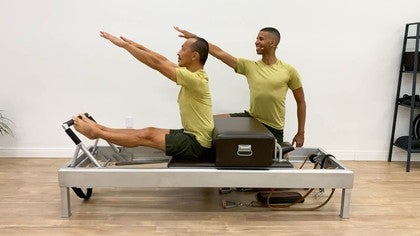
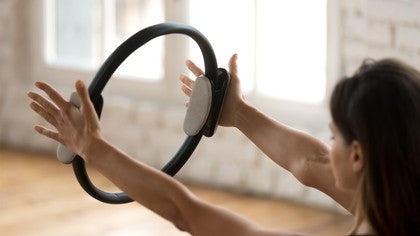
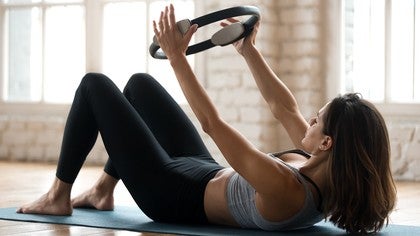
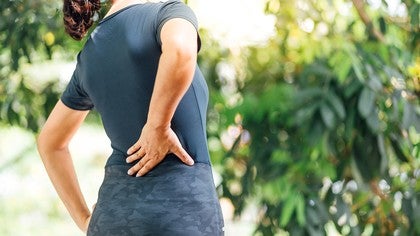
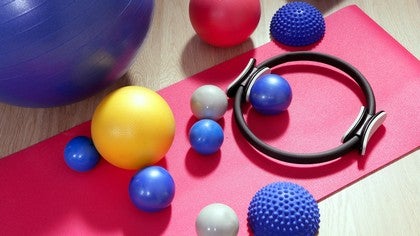

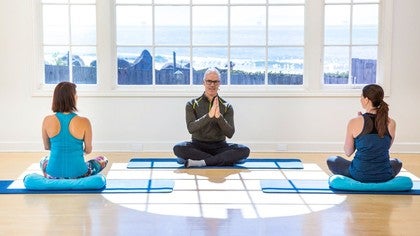

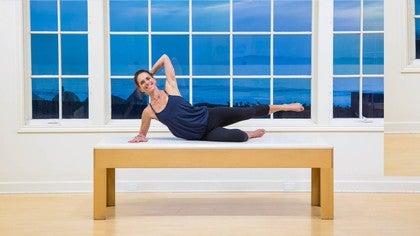
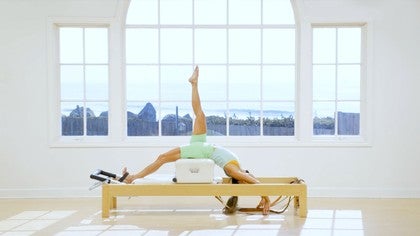


You need to be a subscriber to post a comment.
Please Log In or Create an Account to start your free trial.